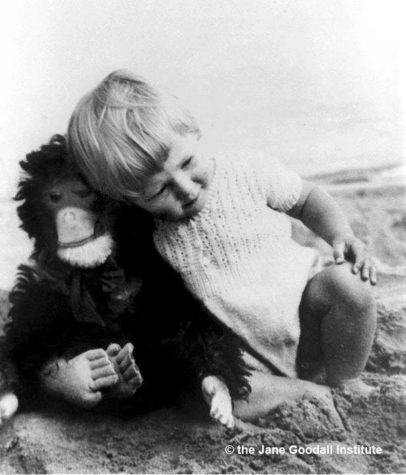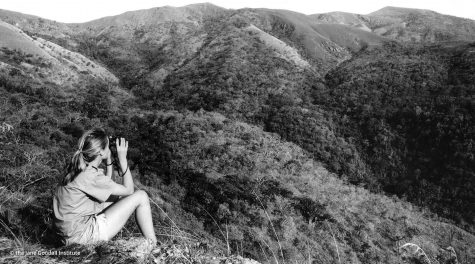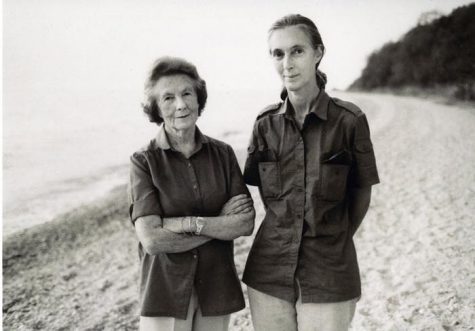Jane Goodall talks life experiences, environmental conservation at FAU
The primatologist, who hasn’t visited FAU in a decade, spoke about her scientific and activist experiences to a crowd of thousands.
March 22, 2019
Walking on stage dressed in a periwinkle kimono, her silver hair tied back and stuffed monkey in arm, Dr. Jane Goodall was greeted with the thunderous applause of thousands during her Tuesday speech.
The scientific pioneer then approached the microphone and greeted the audience with a loud chimpanzee howl.
“That’s how you say hello,” she softly whispered afterward.
Goodall has traveled 300 days out of the year since since 1986, visiting 27 countries last year alone — and one of her stops happened to be Boca Raton. This was Goodall’s third visit to FAU, with the last visit being a decade ago. She shared how she began as a scientist and then unexpectedly turned into a conservation and animal welfare activist through her life’s work to an audience of over two thousand people in the Carole & Barry Kaye auditorium.
At 84, Goodall is still considered the world’s leading expert on chimpanzees. She began her immersive studies nearly 60 years ago living among primates in what is now Tanzania, and her accolades and official titles range from Dame of the British Empire to United Nations Messenger of Peace.
Goodall also holds the title for the world’s longest running continuous wildlife research project, has been featured in over forty films, and has published more than thirty books.
She received her Ph.D in ethology from Cambridge University in 1965 without even having a bachelor’s degree, making her the eighth person in history to do so.
Her life’s journey is a reminder that a simple dream was enough to bring a young girl from the streets of London to the rainforests of East Africa, she said.
A girl abroad

Since a young age, Goodall’s dream was “to grow up, go to Africa, live with wild animals, and write books about animals.”
After secondary school, her career began as a secretary because she couldn’t afford university, and she said her bookkeeping experience was “terribly boring.”
“There was no thought in my mind of becoming a scientist. Women didn’t become scientists back then,” Goodall said.
But she took her first step toward becoming just that at age 26 when a friend invited her to go to Kenya on holiday. She said she worked tirelessly as a waitress to afford the four-week boat journey.
“I left London when the sea was cold and gray, and gradually as we went south, the sea got blue, the air got warmer, the smells coming from the shore got more exotic,” she said.
Once she arrived in Kenya, her friend urged her to contact Louis Leakey, a curator at the Coryndon Memorial Museum in Nairobi. He also was a paleoanthropologist, a scientist that studies ancient human fossils, and Jane was eager to learn from him.
“I think he was amazed that somebody who’d never been to college, who’d come straight from England, knew as much as about African animals as I did. Because I read everything I could,” she said.
Two days before meeting Leakey, his secretary had suddenly quit and luckily, Goodall fit the criteria.
According to Leakey, Goodall had “proper temperament to endure long-term isolation in the wild,” which is why he presented her with the opportunity to study chimpanzees for his research back in Kenya.
Jane of the jungle

Without wasting a minute, Jane would climb the hills of the Gombe Stream Reserve in Tanzania in search of chimpanzees every morning.
“People say, ‘Jane, you’re so brave to go off to the forest alone like that.’ I wasn’t brave. That was my dream,” she said.
Her camp was “primitive,” outfitted with an army tent that could open and allow fresh air inside, but also welcome the likes of spiders, snakes, and scorpions.
Jane eventually grew discouraged because she hadn’t found the results she’d hoped for and money was running out.
“Chimps would look at me and run away. They’ve never seen anything like a white chimp before,” she joked.
But one day, Jane had her breakthrough observation.
“I was walking through a forest trail, and through my binoculars, I saw a chimpanzee who was the first one who began to lose his fear of me. He had a beautiful white beard and I called him ‘David Greybeard.’ Through my binoculars I saw a hand reach out, break off a grass stem, push it down into a termite mound, and ate off the termites,” she said.
Goodall reminded the audience that in 1960, witnessing a chimpanzee fashion a tool was groundbreaking, since the scientific community thought only humans were capable of doing that.
“When I first began sending in reports about tool-using and about some of the other amazing behaviors I’ve seen, there were many scientists who said ‘Why should you believe her? She’s not been to college, and she’s just a girl,’” she said.
Goodall explained that chimpanzees have behaviors just like humans, varying from community and region.
“They remind me so much of some human politicians … And I didn’t even say it,” she whispered through the roaring laughter and cheering.
Think like a scientist, act like an activist

After completing her Ph.D, Goodall returned to Gombe and set up a research station, receiving a few students on the 22-mile stretch of land. She felt a strong spiritual connection with the rainforest, even calling that experience the best days of her life.
But those days wouldn’t last.
At an October 1986 conference in Chicago, scientists studying chimpanzee behavior in other parts of Africa came together for the first time. She recalled that at one session, the group of scientists were startled to see chimpanzee populations dwindle because of deforestation and poaching.
Goodall could not sleep for nights after seeing footage of the chimps locked in cramped cages in a medical research facility.
“I went to the conference as a scientist, planning to carry on with my wonderful life, but I left as an activist,” she admitted.
Most of her time traveling is now spent with Roots and Shoots, her youth service program dedicated to empowering young people in leadership, animal welfare, and conservation. The organization has 10,000 groups in more than 100 countries.
“People say, ‘Jane, you must love traveling,’” she mocked. “I hate it.”
She’s not alone on her trips, though.
Goodall introduced the audience to a stuffed monkey at her side, Mr. H, with the H standing for hope. She brings him to all her presentations across 59 countries worldwide.
Around the world, she finds that many young people, particularly high school and university students, have seem to lost hope in preserving the environment. They often tell Goodall that older generations have “compromised” their future and there’s nothing they can do about it.
“Have we compromised the future of our young people? Just the same as we have inherited this planet from our parents, we borrowed it from our children. But we haven’t been borrowing our children’s future have we? We’ve been stealing it,” she said.
But Goodall ultimately offers a message of hope.
“But is it true that there’s nothing young people can do about it? I believe that there’s a window of time, and if we get together we can start to heal some of the harm we’ve inflicted. We can at least slow down climate change,” she said.
Israel Fontoura is a student government editor with the University Press. For information regarding this or other stories, Tweet him at @israelofontoura or email ifontoura2018@fau.edu.







